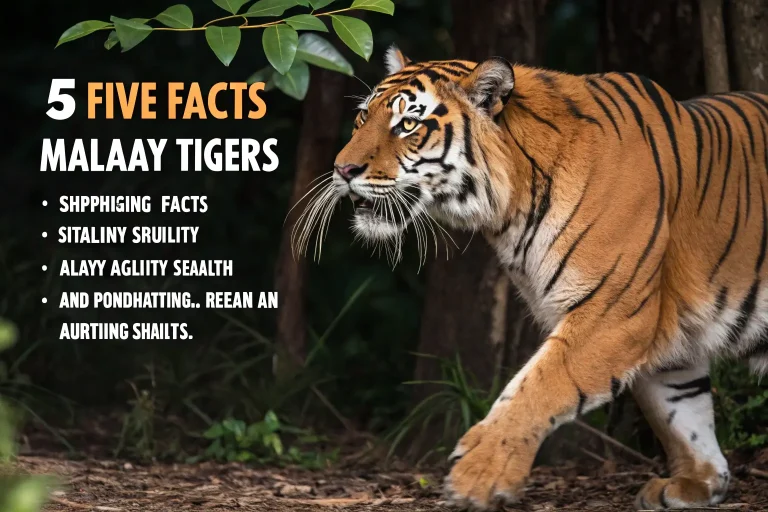Malay Tiger Mystique: 8 Reasons Why They Captivate Us
Are you fascinated by the elusive Malay tiger? Dive into eight intriguing reasons why this majestic creature captures our hearts and imaginations. Uncover the secrets of the Malay tiger’s allure and get tips on how to support their conservation. Discover their mystique now!
Introduction
The Malay tiger, a magnificent apex predator unique to the Malay Peninsula, stirs something primal in the human psyche. With its distinctive striped coat and powerful presence, this endangered big cat represents both the wild beauty of Southeast Asian jungles and the fragility of our natural world. The Malay tiger once prowled freely through dense rainforests but now teeters on the brink of extinction.
Understanding this subspecies becomes increasingly crucial as fewer than 150 individuals remain in the wild. Beyond conservation urgency, these tigers hold cultural significance for indigenous communities and serve as environmental indicators for ecosystem health. Their story intertwines with our own, revealing humanity’s complex relationship with wilderness.
Did you know the Malay tiger possesses unique genetic markers that distinguish it from other tiger subspecies? Only recognized as a distinct subspecies in 2004, these tigers remain among the least-studied big cats on Earth—their secretive nature and dwindling numbers creating an air of mystery that further fuels our fascination.
Species Overview
Scientific Name: Panthera tigris jacksoni
The Malay tiger, scientifically classified as Panthera tigris jacksoni, earned its subspecies recognition relatively recently in 2004. Named after the tiger conservationist Peter Jackson, this classification distinguishes it from its closest relative, the Indochinese tiger (Panthera tigris corbetti). Genetic studies have confirmed its unique DNA markers and evolutionary history.
Physical Characteristics
Malay tigers generally appear smaller than their Bengal or Siberian counterparts, with males typically weighing between 220-300 pounds (100-136 kg) and measuring 7.5-8.5 feet (2.3-2.6 meters) in length. Females are slightly smaller, averaging 180-240 pounds (81-109 kg).
Their coat features a vibrant orange-to-reddish background with distinctive black stripes. These stripes serve as a fingerprint of sorts—no two tigers share identical patterns. The Malay tiger typically displays narrower stripes compared to some other subspecies, with darker orange fur adapted to the dense, shadowy rainforest environment. Their white belly and facial markings create striking contrast against their main coloration.
Strong muscular limbs, powerful jaws capable of exerting 1,000 pounds of force, and retractable claws measuring up to 4 inches make them formidable hunters. Their night vision operates about six times better than human vision, allowing them to navigate and hunt effectively in low light conditions.
Subspecies
The Malay tiger represents one of only six remaining tiger subspecies worldwide, following the extinction of three other subspecies during the 20th century. While no further subspecies divisions exist within the Malay tiger population, researchers have noticed subtle variations between northern and southern populations, potentially indicating ongoing evolutionary adaptations to slightly different habitats.
Habitat and Distribution
Natural Habitat
The Malay tiger thrives exclusively within the tropical rainforests of the Malay Peninsula. These ancient forests provide the dense vegetation, fresh water sources, and abundant prey essential for their survival. Preferring remote forested regions with minimal human disturbance, these cats require large territories with diverse ecological features—from lowland dipterocarp forests to hilly tropical evergreen woodlands.
The thick undergrowth provides perfect concealment for ambush hunting, while waterways offer important hydration sources and attract prey animals. This environment also supports the tigers’ territorial behavior, with natural landmarks often serving as boundary markers between individual ranges.
Geographic Range
Historically, Malay tigers roamed throughout the entire Malay Peninsula, including southern Thailand, Malaysia, and possibly parts of Singapore before its extensive development. Today, their range has contracted dramatically, with remaining populations primarily confined to three major forest complexes in Peninsular Malaysia: Belum-Temengor, Taman Negara, and Endau-Rompin. Small scattered populations may exist in other protected areas, though these likely contain too few individuals to maintain genetic viability without conservation intervention.
Southern Thailand may harbor a minimal number of these tigers, although confirmation remains challenging due to their rarity and elusive nature. Their current range represents less than 40% of their historical distribution.
Adaptations
Malay tigers have evolved numerous adaptations perfectly suited to their rainforest habitat. Their narrower stripes blend seamlessly with the dappled sunlight filtering through dense canopies, while their slightly smaller size compared to northern tiger subspecies allows for easier movement through thick vegetation.
Their strong swimming ability helps them navigate the numerous rivers and streams crisscrossing their habitat. During monsoon seasons, these waterways often flood, creating natural barriers that Malay tigers cross with ease while their prey may struggle.
Unlike many big cats, Malay tigers don’t avoid water—they readily use it for hunting, cooling off during hot days, and as travel corridors. These adaptations, combined with acute senses specialized for detecting prey in dense forest environments, make them the ultimate rainforest predator.
Diet and Feeding Habits
What It Eats
The Malay tiger maintains a carnivorous diet centered primarily on medium to large ungulates native to Southeast Asian forests. Wild boar, sambar deer, barking deer, and serow constitute their preferred prey. Additionally, they opportunistically hunt smaller mammals like macaques, porcupines, and bearded pigs when available.
A single adult tiger typically consumes approximately 50 large prey animals annually. After making a kill, a tiger may feed for several days on a single carcass, consuming up to 88 pounds (40 kg) of meat in one sitting before concealing the remains under vegetation to prevent scavengers from stealing their meal.
Hunting or Foraging Behavior
Unlike many big cats that hunt in open savannahs, the Malay tiger has perfected forest hunting techniques. Their strategy relies heavily on stealth and patience rather than sustained pursuit. They silently stalk prey, moving with surprisingly little sound despite their size, often approaching within 20-30 feet before launching their ambush.
These solitary hunters attack with explosive speed, covering short distances at up to 40 mph to overtake prey before it can react. They typically kill by delivering a powerful bite to the throat or neck, severing the spinal cord or suffocating the prey. Their hunting success rate ranges from 10-20%, meaning many stalking attempts end without success—requiring persistent hunting behavior.
Water sources serve as strategic hunting locations, with tigers sometimes waiting for hours near forest paths leading to rivers where prey animals must eventually come to drink.
Dietary Needs
An adult Malay tiger requires approximately 10-15 pounds (4.5-6.8 kg) of meat daily on average, though they don’t eat every day. Their feast-or-famine pattern means they may go several days without feeding after a large meal.
Their diet provides essential nutrients, particularly proteins and fats required for maintaining their muscular physique and supporting high-energy hunting behavior. The humid rainforest environment also necessitates regular hydration, with tigers often hunting near water sources that simultaneously attract prey.
Female tigers with cubs need substantially more calories to support milk production. This increased energy requirement often drives more frequent hunting, placing additional pressure on nursing mothers in environments where prey has become scarce due to human activities.
Behavior and Social Structure
Social Behavior
Malay tigers epitomize solitary living, with adults interacting primarily during mating seasons. Each tiger maintains and defends a territory against same-sex intruders while potentially overlapping with opposite-sex territories. Male territories typically span 150-300 square kilometers, encompassing the smaller territories of several females (60-150 square kilometers).
Despite their solitary nature, these tigers maintain a complex “social network” through scent marking, scratch marks on trees, and vocalizations that communicate territorial boundaries, reproductive status, and identity. This system allows tigers to avoid confrontations while maintaining awareness of neighboring individuals.
Unlike lions, Malay tigers never form prides. Mothers raise cubs alone for approximately two years before the young disperse to establish their own territories—males typically traveling farther from their birth area than females.
Communication
The Malay tiger utilizes a sophisticated communication system combining scent, sound, and visual signals. Their distinctive roar can carry for miles through the dense forest, serving both as territorial declaration and mate attraction. Beyond full roars, they produce an array of vocalizations including chuffs (friendly greeting sounds), growls, hisses, and snarls for different social contexts.
Scent marking represents their primary communication method, with urine sprayed on vegetation containing chemical signatures unique to each individual. These scent markers convey information about sex, reproductive status, and territory ownership, essentially creating an invisible landscape of information for other tigers.
Visual signals include facial expressions, ear positions, and tail movements that communicate immediate emotional states during rare direct encounters. Scratch marks on prominent trees serve as visual territorial markers that persist even when scent fades.
Mating and Reproduction
The reproductive cycle of the Malay tiger begins when a female enters estrus, typically lasting 3-7 days, during which she communicates her receptivity through increased scent marking and vocalizations. Males may travel considerable distances following these signals, occasionally resulting in competitive encounters between rival suitors.
Mating occurs frequently during this period—sometimes 50-100 times over several days—to ensure successful conception. After a gestation period of approximately 103-105 days, females give birth to 2-4 cubs in a secluded den, often located in dense vegetation, caves, or hollow tree cavities.
Cubs weigh only 2-3 pounds (0.9-1.4 kg) at birth and remain blind for their first week. The mother provides exclusive care, hunting alone and leaving cubs hidden while she secures food. Approximately 50% of cubs survive to independence at about 18-24 months of age. Females reach sexual maturity around 3-4 years, while males typically mature at 4-5 years.
In the wild, Malay tigers live 10-15 years on average, though some individuals may reach 20 years under ideal conditions.
Conservation Status

Endangerment Level
The Malay tiger faces imminent extinction, classified as Critically Endangered on the IUCN Red List. Current estimates suggest fewer than 150 individuals remain in the wild—potentially as few as 80-120 tigers—representing a catastrophic 95% population decline since the early 20th century.
This dire situation places the Malay tiger among the most endangered big cats globally. At current rates of decline, experts warn they could disappear from the wild within the next decade without intensive intervention. Their small population size creates additional challenges through genetic bottlenecking, reduced reproductive potential, and increased vulnerability to disease outbreaks.
Threats
Poaching constitutes the most immediate threat to Malay tiger survival. Despite legal protections, tigers are killed for their pelts, bones, and body parts valued in traditional medicine markets. A single tiger can fetch up to $50,000 on black markets, creating powerful financial incentives for poachers.
Habitat loss and fragmentation through deforestation for palm oil plantations, timber harvesting, and infrastructure development have destroyed approximately 80% of Malaysia’s original forest cover. The remaining habitat exists as increasingly isolated fragments, preventing tigers from establishing viable territories and finding mates.
Prey depletion from commercial hunting and subsistence poaching further compounds these threats. As ungulate populations decline, tigers struggle to secure adequate nutrition, leading to reduced reproductive success and occasional human-wildlife conflict when desperate tigers approach settlements searching for livestock.
Climate change presents an emerging threat, with altered rainfall patterns and increasing temperatures potentially disrupting the ecological balance of rainforest habitats that support both tigers and their prey species.
Conservation Efforts
Multiple organizations coordinate to protect remaining Malay tigers. The Malaysian Conservation Alliance for Tigers (MYCAT) unites government agencies and NGOs in collaborative conservation strategies. Their efforts include anti-poaching patrols, habitat protection initiatives, and community education programs.
Wildlife corridors connecting fragmented forest patches help maintain genetic diversity by allowing tigers to move between otherwise isolated populations. The Central Forest Spine initiative in Malaysia aims to reconnect major forest complexes through strategic land protection and reforestation.
Advanced monitoring technologies such as camera traps, satellite tracking, and DNA analysis help researchers assess population dynamics and target conservation efforts. Some conservationists advocate for captive breeding programs as insurance against extinction, though controversy exists regarding their effectiveness compared to wild protection efforts.
International cooperation between Malaysia, Thailand, and global conservation organizations provides financial resources, technical expertise, and political pressure to strengthen protection for these critically endangered cats.
Interesting Facts
The Malay tiger possesses incredible jumping power, capable of leaping over 16 feet horizontally and up to 10 feet vertically despite weighing hundreds of pounds. This remarkable athletic ability allows them to overcome natural obstacles and capture prey with explosive bursts of movement.
Unlike domestic cats, tigers genuinely enjoy water. Malay tigers regularly swim across rivers and lakes, sometimes traveling several miles through water and demonstrating remarkable endurance. During extreme heat, they often lounge in streams and pools, submerging themselves to cool off—behavior rarely seen in other big cat species.
Each tiger’s whiskers contain a unique arrangement of highly sensitive nerve endings that function like fingertips, helping them navigate through pitch-black forests at night. These whiskers detect subtle air movements, allowing tigers to sense nearby objects and prey even in complete darkness.
Tiger saliva contains antiseptic compounds that help prevent infection when they clean wounds. This natural antibiotic quality enables them to recover from injuries that might prove fatal to other animals lacking such adaptations.
The cultural significance of Malay tigers extends deeply into local mythology. In traditional Malaysian folklore, tigers represented both protection and danger—spiritual beings capable of shapeshifting between human and tiger forms. Some indigenous communities considered them ancestral spirits deserving reverence rather than fear.
Female tigers possess incredible maternal memory, often returning to successful hunting grounds and safe denning locations they’ve used in previous years when raising new litters—demonstrating sophisticated spatial cognition and long-term memory capabilities.
Tips for Supporting Malay Tiger Conservation
Supporting responsible ecotourism creates economic incentives for protecting tiger habitats. When visiting Malaysia, choose tour operators with demonstrated commitments to conservation and local community development. These businesses often contribute portions of their proceeds directly to tiger protection efforts.
Reduce consumption of products containing palm oil or seek those using sustainably certified sources. The palm oil industry drives significant deforestation within the Malay tiger’s range, so consumer choices directly impact habitat preservation.
Consider “adopting” a tiger through reputable conservation organizations like the World Wildlife Fund. These symbolic adoptions fund critical conservation initiatives including anti-poaching patrols, habitat restoration, and community education programs.
Follow and share accurate information about Malay tiger conservation on social media. Increased awareness helps generate public pressure for stronger protection policies and counteracts misinformation that sometimes fuels illegal wildlife trade.
Support organizations working directly with local communities near tiger habitats. Programs helping villagers develop sustainable livelihoods reduce dependence on forest resources and decrease human-wildlife conflict scenarios.
Advocate for stronger international restrictions on wildlife trafficking. Contact elected officials urging support for legislation that imposes meaningful penalties on wildlife traffickers and countries failing to enforce existing protections.
Role in the Ecosystem
Ecological Importance
As apex predators, Malay tigers regulate prey populations through direct predation, preventing overgrazing and maintaining forest health. Their hunting preferences for certain herbivores create cascading effects throughout the ecosystem—preserving plant diversity by preventing any single plant-eating species from becoming dominant.
Tigers indirectly protect carbon-sequestering forests by controlling herbivore populations that might otherwise consume excessive vegetation. This relationship between predators, prey, and plants helps maintain the rainforest as an effective carbon sink, contributing to climate stability.
The mere presence of tigers in an ecosystem influences prey behavior through the “ecology of fear,” where herbivores alter feeding patterns to avoid predation. This behavioral change prevents continuous feeding in any single area, allowing plant communities time to recover and promoting biodiversity across the landscape.
Scavengers and decomposers benefit from tiger kills, with partial carcasses supporting numerous other species from vultures to insects. This energy transfer through the ecosystem demonstrates the interconnectedness of forest food webs.
Impact of Decline
The loss of Malay tigers would trigger ecological cascades throughout Southeast Asian forests. Without this apex predator, herbivore populations—particularly wild boar and deer species—would likely increase dramatically, potentially leading to overgrazing of certain plant species and altering forest composition.
Such changes could reduce overall biodiversity as ecosystem balance shifts. Plant species preferred by suddenly abundant herbivores might face localized extinction, while less palatable species would proliferate, potentially decreasing forest productivity and resilience.
The tiger’s disappearance would eliminate a crucial selective pressure that has shaped prey species’ evolution for thousands of years. Over time, this could alter various traits in prey populations from vigilance behaviors to physical attributes previously optimized for predator avoidance.
Beyond ecological impacts, the extinction of the Malay tiger would represent an irreplaceable cultural loss for indigenous communities whose identities, art, and spiritual practices have incorporated tiger symbolism for countless generations.
Conclusion
The Malay tiger embodies wilderness in its purest form—power, beauty, and mystery seamlessly combined in an animal perfectly adapted to its rainforest realm. From its specialized hunting techniques to its crucial role in maintaining ecosystem health, this magnificent predator represents far more than simply another endangered species.
The critical endangerment of these tigers reflects fundamental challenges in our relationship with the natural world. Their decline mirrors broader patterns of biodiversity loss occurring globally, serving as both warning and opportunity. By protecting Malay tigers, we simultaneously preserve complex ecosystems benefiting countless other species and ultimately ourselves.
Each remaining Malay tiger represents a living link to our evolutionary past—a reminder of times when humans existed not as conquerors of nature but as participants within it. Their continued existence depends entirely on human choices made in coming years: whether to prioritize short-term resource extraction or sustainable coexistence with the natural systems supporting all life.
The choice to protect these tigers transcends conservation alone—it reflects who we wish to be as a species and what values we hold for future generations. Will we allow one of Earth’s most magnificent creatures to vanish forever, or summon the collective will to ensure Malay tigers continue roaming Southeast Asian forests for centuries to come? The answer lies in our hands.
Frequently Asked Questions
How many Malay tigers remain in the wild?
Current estimates indicate fewer than 150 Malay tigers survive in the wild, with some researchers suggesting the actual number may be closer to 80-120 individuals. This population has declined over 95% since the early 20th century, primarily due to poaching and habitat loss.
What makes the Malay tiger different from other tiger subspecies?
The Malay tiger (Panthera tigris jacksoni) is genetically distinct from other subspecies, with slightly smaller average size, narrower stripes, and specific adaptations to humid rainforest environments. Only recognized as a separate subspecies in 2004, it evolved unique characteristics suited to the Malay Peninsula’s ecological conditions.
Can Malay tigers be viewed in the wild?
While technically possible, spotting wild Malay tigers is extremely rare due to their critically endangered status and naturally secretive nature. Some protected areas in Malaysia offer guided wildlife tours, but visitors should maintain realistic expectations. The best chance to observe these tigers is through specialized photography hides managed by conservation organizations, though sightings remain exceptional events.
How large is a Malay tiger’s territory?
Male Malay tigers maintain territories averaging 150-300 square kilometers (58-115 square miles), while females typically control smaller ranges of 60-150 square kilometers (23-58 square miles). Territory size varies based on prey availability, habitat quality, and tiger population density.
What do Malay tigers eat?
Malay tigers primarily hunt wild boar, sambar deer, barking deer, and serow. They opportunistically take smaller prey like macaques and porcupines when available. An adult tiger typically consumes 10-15 pounds of meat daily on average, often feeding on a single large kill over several days.
How long do Malay tigers live?
In the wild, Malay tigers typically live 10-15 years, though some individuals may reach 20 years under ideal conditions. In protected captive environments with proper care, they occasionally survive into their early 20s, though captive breeding programs specifically for this subspecies remain limited.
Why are Malay tigers important for the ecosystem?
As apex predators, Malay tigers regulate prey populations, preventing herbivore overpopulation that could damage forest vegetation. Their presence creates cascading effects throughout the ecosystem, maintaining biodiversity and ecological balance. Their hunting patterns influence prey behavior, indirectly affecting plant community composition and forest health.
What can I do to help save the Malay tiger?
You can support Malay tiger conservation by donating to organizations like the Malaysian Conservation Alliance for Tigers (MYCAT) or World Wildlife Fund, choosing sustainable palm oil products to reduce habitat destruction, advocating for stronger anti-poaching enforcement, and raising awareness about their critical situation. Even small actions collectively contribute to protecting these magnificent cats from extinction.







